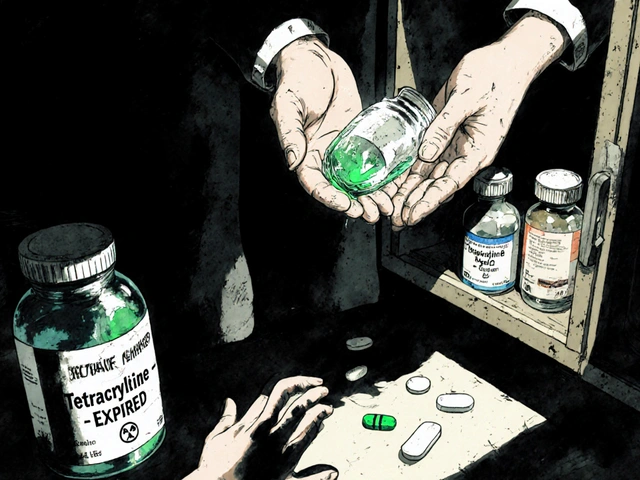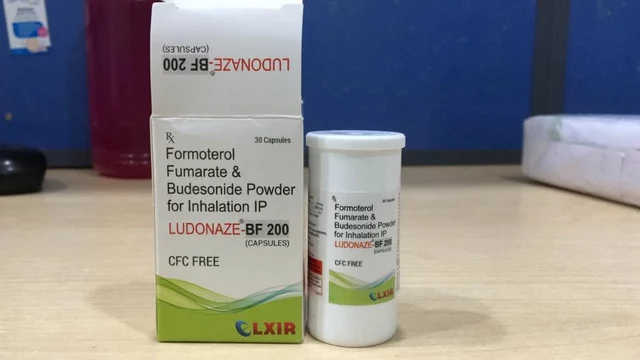If you’ve been popping Famotidine for your heartburn or acid reflux and not getting relief, you’re definitely not alone. Plenty of us have switched meds or added another approach just to keep that fiery chest pain at bay. The problem? There’s a confusing pile of alternatives, each with different effects and quirks.
Instead of guessing, I’ll walk you through the most popular swaps—what they do, who they’re good for, and what to watch out for. This isn’t just random info; it’s the stuff your doctor would actually discuss after you say, “Famotidine’s just not working anymore.”
Stick around if you want real talk on acid-stopping meds, from familiar picks like omeprazole to the heavy-duty options your doctor might bring up. Plus, there’s a section on natural and non-drug routes, in case you’re looking to avoid more pills.
- Omeprazole (Prilosec)
- Ranitidine Alternatives
- Esomeprazole (Nexium)
- Lansoprazole (Prevacid)
- Cimetidine (Tagamet)
- Dexlansoprazole (Dexilant)
- Lifestyle & Natural Alternatives
- Comparing The Options
Omeprazole (Prilosec)
Let’s talk about Omeprazole, a big name in acid reflux meds that you’ve probably seen all over your local pharmacy. It’s usually branded as Prilosec and, like Famotidine, it helps knock down that awful burning from acid reflux. But here’s the thing: while Famotidine is an H2 blocker, Omeprazole is a PPI—that stands for proton pump inhibitor, and it works a bit differently. Instead of just slowing down acid production, PPIs like Omeprazole actually shut down the pumps in your stomach that make acid in the first place.
People use Omeprazole for conditions ranging from GERD (gastroesophageal reflux disease) and regular heartburn to stomach ulcers and even damage from acid in the esophagus. It usually takes about a day for Omeprazole to fully kick in, but it offers longer-lasting relief than most over-the-counter antacids. That’s why a lot of folks with chronic symptoms switch to it if H2 blockers aren’t cutting it.
Here’s a quick look at what sets Omeprazole apart, especially if you’re trying to figure out what might help where Famotidine hasn’t.
Pros
- Provides up to 24-hour relief with once-daily dosing
- Works well for frequent (2+ times per week) heartburn or GERD
- Available in prescription and non-prescription strengths
- Proven to help heal erosive esophagitis over a few weeks
Cons
- Takes 1–4 days to see full effect—doesn’t work instantly for new heartburn pain
- Possible long-term side effects: lower magnesium, B12 deficiency, increased risk for gut infections if used for months
- Can interact with other medications like clopidogrel
- The FDA recommends not using over-the-counter Omeprazole for more than 14 days unless you talk to your doctor
If you’re a numbers person, here’s what national data looked like for Omeprazole vs. Famotidine in a real-world setting:
| Medication | Average Time to Relief | Typical Duration of Effect | Common Use |
|---|---|---|---|
| Omeprazole (PPI) | 1–4 days | 24 hours | Frequent/Chronic heartburn, GERD |
| Famotidine (H2 blocker) | 1 hour | 6–12 hours | Occasional heartburn, mild reflux |
So if you want something for long-haul control—even if it takes a bit to kick in—Omeprazole is worth bringing up at your next appointment. Just don’t expect instant magic the first day you take it.
Ranitidine Alternatives
Remember when ranitidine (Zantac) was everywhere for heartburn and GERD? Things changed in 2020 when the FDA pulled it off US shelves due to contamination concerns. If you lost your go-to remedy and wondered, “Now what?” you’re not alone—millions had to switch almost overnight.
The most direct alternatives to ranitidine are other H2 blockers and PPIs (proton pump inhibitors). The two main H2 blockers left are famotidine (which you might already know) and cimetidine (Tagamet). PPIs, like omeprazole and lansoprazole, also became more popular for folks looking to replace ranitidine.
Here’s a quick need-to-know:
- Famotidine (Pepcid): Most common H2 alternative, works in a similar way to ranitidine but often with fewer drug interactions and a better safety profile.
- Cimetidine (Tagamet): Effective but known for messing with lots of other meds. It’s fallen out of favor for that reason, but it’s still available.
- Proton Pump Inhibitors (PPIs): These include omeprazole (Prilosec), esomeprazole (Nexium), and others. They don’t just block acid temporarily—they tamp it down long-term. Often used if H2 blockers aren’t enough.
One big stat: After ranitidine was pulled, famotidine sales jumped almost 25% in the US over the next six months. Pharmacies kept running low for a while, so people had to try several options before finding the right fit.
Here’s how the main choices stack up for former ranitidine users:
| Alternative | How Fast? | How Long? | Common Issues |
|---|---|---|---|
| Famotidine | Within 1 hour | 6-12 hours | Rare headaches, less drug interactions |
| Cimetidine | Within 1 hour | 4-8 hours | Lots of drug interactions, hormone effects |
| PPIs (e.g. Omeprazole) | 1-4 days for full effect | Once-daily, long-lasting | B12/magnesium issues, possible long-term risks |
Quick tip: If you’re replacing ranitidine for the first time, talk to a doctor or pharmacist about your current meds. Cimetidine especially can mess with things like blood thinners, antidepressants, and heart meds. PPIs need a few days to kick in, but they can be game-changers for severe or chronic symptoms.
And don’t assume what worked for someone else will work for you—some folks get relief from a simple diet tweak, while others need a complete medication overhaul. It’s definitely a period of trial and error when heartburn is your daily guest.
Esomeprazole (Nexium)
Here’s the thing: if Famotidine isn’t keeping your reflux in check, a lot of doctors will nudge you toward proton pump inhibitors like Esomeprazole. Nexium—yep, that famous purple pill—goes a step further than H2 blockers by totally turning down acid production in your stomach. For people dealing with stubborn acid reflux or getting woken up by heartburn at night, that’s a gamechanger.
Esomeprazole is usually taken once a day—though sometimes, with extra tough symptoms, the dose gets doubled. You’ll often notice improvement in just a few days, but for some folks, it might take up to a week. Nexium is also approved for healing erosive esophagitis, which is basically when acid burns your esophagus, and for keeping long-term GERD in check.
Pros
- Works fast and can bring more complete relief than Famotidine, especially for severe GERD
- Just one pill a day for most cases—super simple routine
- Heals esophagus damage, not just gives symptom relief
- Comes in prescription strengths, but also available OTC if you’re self-managing mild symptoms
Cons
- Needs a couple days to kick in—not great for sudden, severe heartburn
- Long-term use may mess with nutrients like magnesium and B12
- Possible side effects: headache, stomach pain, diarrhea—for some, it can get worse
- Higher cost than generic acid reflux meds
Doctors used to put people on PPIs like Nexium for years without blinking. Lately, though, there’s more chatter about keeping the dose as low as possible and not staying on it forever. There’s data connecting long-term PPI use to increased risks for gut infections, bone fractures, and kidney issues.
| How Fast It Works | Typical Dose | Best For |
|---|---|---|
| Relief in 1-7 days | 20-40mg once daily | Severe or frequent GERD, esophagus healing |
If you’re curious about switching to Esomeprazole or adding it to your game plan, talk with your provider. It can be a huge win for getting those brutal reflux flares under control—but it’s smart to revisit your dose or just how long you’re taking it every so often.
Lansoprazole (Prevacid)
Lansoprazole, sold under the name Prevacid, is a proton pump inhibitor (PPI) that works by seriously reducing how much acid your stomach makes. If Famotidine isn’t doing the trick for stubborn acid reflux, esophagitis, or GERD, doctors often turn to PPIs like lansoprazole because they’re more powerful and act longer.
People usually take Prevacid once a day, often before breakfast, but doctors sometimes bump it to twice daily for really tough cases. It takes a day or two to really kick in, so don’t expect instant relief like what you might get from an antacid. But when it works, folks notice a pretty big drop in heartburn, regurgitation, and even that sore throat feeling you get after a bad acid flare-up.
There’s also an OTC version, which makes it pretty easy to try—though it’s smart to check with your doctor, especially if you need to use it longer than two weeks. It’s FDA approved for both adults and kids over a year old for reflux, so it’s a solid option for families dealing with these issues.
Pros
- Stronger and longer-lasting acid suppression than Famotidine.
- Effective for frequent or severe GERD symptoms.
- Well-studied with lots of data to back up its safety for short-term use.
- Available OTC and by prescription, so options fit most insurance plans.
- Tolerated by most people, even for several months at a time.
Cons
- Possible long-term side effects with months or years of use—think B12 deficiency, magnesium issues, or a small bump in infection risks.
- Doesn’t offer immediate relief like chewable heartburn tablets.
- Can interact with certain meds, such as blood thinners, HIV drugs, or antifungals.
- Some people report headaches, stomach pain, or mild diarrhea when starting.
- Kids need dosing carefully checked, especially if using beyond a couple weeks.
| How Long Until Relief? | Effectiveness (GERD) | OTC Approved? |
|---|---|---|
| 1-4 days | 75-89% | Yes |
If you’re hitting that point where nothing is cutting the nightly heartburn, Prevacid is worth asking about. Doctors consider it a go-to when H2 blockers, like Famotidine, just aren’t enough. Just remember: don’t stay on it longer than you need—always circle back to your doctor if you’re considering long-term use.

Cimetidine (Tagamet)
Cimetidine, or as you’ll see it on the pharmacy shelf—Tagamet—was actually the first H2 blocker out there. It’s been around since the ’70s, so doctors and pharmacists know this med inside and out. Like Famotidine, it helps chill out your stomach’s acid production by blocking histamine at the H2 receptors. This is helpful for heartburn, GERD, ulcers, and sometimes even conditions where you’ve got way too much stomach acid.
One thing people notice with Cimetidine is it's available over the counter, so you don’t have to mess with a prescription if you need something fast. It usually kicks in within 30 to 60 minutes. If you’re dealing with late-night heartburn from spicy pizza or a stressful day, that quick relief is clutch. It’s also one of the few acid reducers people sometimes use short-term after a heavy meal or drinking alcohol.
But, let’s be real: Cimetidine has some issues that other acid reflux meds don’t. It tends to stick around longer in your system and messes with the way your body handles other medications. If you take things like warfarin, certain heart meds, or antidepressants, you have to be extra careful—interaction central. Oh, and it can mess with some hormone levels, so doctors usually avoid it in men at risk for gynecomastia (that’s when guys get breast tissue).
Pros
- Fast relief for heartburn and acid reflux, usually within an hour
- Available over the counter and easy to find
- Can be used short-term after certain foods or drinks
- Cost-effective versus newer options
Cons
- Can interact with a ton of common medications
- Possible hormonal side effects like gynecomastia (rare, but real)
- Not always the best for long-term use in younger adults
- Side effect risk, especially in older patients (think confusion or kidney issues)
Not sure how Cimetidine stacks up to the others? Here’s a quick look at some stats on drug interactions compared to newer H2 blockers:
| Medication | Estimated Major Drug Interactions |
|---|---|
| Cimetidine (Tagamet) | More than 100 known |
| Famotidine | About 20 |
Bottom line: Cimetidine gets the job done if you want something quick and affordable, but don’t pick it if you’re juggling other prescription meds or if your doctor warns you about hormone side effects. Always talk to a healthcare provider before trying it if you’re already taking anything else daily.
Dexlansoprazole (Dexilant)
If you’re fighting tough acid reflux or GERD and famotidine doesn’t cut it, Dexlansoprazole (Dexilant) is worth learning about. It’s a proton pump inhibitor (PPI), but what’s unique is its delayed-release formula. This means it keeps working longer than typical PPIs, covering you for both daytime and nighttime symptoms.
You usually take it once a day—super convenient if you’re tired of midday dosing. Dexilant’s especially popular with folks who wake up to that annoying burning, since its dual-release action stretches out the acid control.
For those who worry about side effects, Dexilant tends to have a similar safety profile as other PPIs but seems to trigger fewer headaches and diarrhea for some people. Still, you have to be careful, especially if you need it for months. Long-term risks (like low magnesium and bone thinning) are still in play, just like with the rest of the PPI family.
Cost can be a bummer here—Dexilant is often pricier than other options, and insurance companies don’t always cover it first line. Double-check with your pharmacist or doctor about coverage before committing.
Pros
- Lasts longer than standard PPIs, so you get more consistent relief from acid reflux and GERD.
- Once-daily dosing is great if you forget mid-day pills.
- Can reduce nighttime symptoms thanks to the dual-release action.
- Lower rates of common PPI side effects in some users.
Cons
- Usually costs more than famotidine or generic PPIs.
- Has the same long-term risks as other PPIs (think low magnesium, vitamin B12 issues, bone thinning).
- May trigger insurance hassles; some plans need you to fail cheaper PPIs first.
- You might need to adjust meal timing—taking it before meals usually works best.
Side tip: If you have a job with unpredictable hours or hate planning your meds around meals, Dexilant’s forgiving schedule will feel like a win. Still, always talk with your doctor before making the jump, since everyone’s reflux and risk factors look a little different.
| Dexlansoprazole (Dexilant) | Famotidine |
|---|---|
| Delayed-release, once-daily, longer duration | Shorter duration, sometimes needs twice a day |
| Prescription only, higher cost | Available OTC, cheaper |
| Effective for tough or nighttime symptoms | Best for mild-to-moderate, predictable symptoms |
Lifestyle & Natural Alternatives
Sometimes, fixing heartburn isn’t just about swapping meds like Famotidine or Prilosec. Simple tweaks to your habits or trying natural remedies can make a real difference. They might not replace meds if you have severe acid reflux or GERD, but for a lot of people, they really help reduce symptoms or even make them go away entirely.
First, let's talk food. Fatty, spicy, or acidic foods (think pizza, citrus, or hot wings) are heartburn’s best friends—in the worst way. Cutting back on these, especially at dinner, usually leads to less night-time burn. Eating smaller meals more often, instead of one big meal, also means your stomach doesn’t get overloaded and start pushing acid back up. Don’t lie down right after eating either; wait at least two to three hours before you crash on the couch or head to bed.
Next up: weight and stress. Carrying extra pounds, especially around the belly, puts pressure on your stomach and can make acid reflux worse. Dropping just 10 pounds can make a surprisingly big difference. Stress is another trigger—when you’re tense, your gut acts up. Simple stuff like short walks, breathing exercises, or ten minutes of stretching before bed help a lot of people.
Let’s look at the basics in a nutshell:
- Keep your head up: Sleeping on a slight incline (stack a couple of pillows or raise the head of your bed 6-8 inches) keeps stomach acid where it belongs at night.
- Quit smoking and ease up on booze: Both weaken the muscle that keeps acid in your stomach. Even cutting down helps.
- Wear loose clothes: Tight belts and pants push on your gut and make symptoms worse.
- Chew gum: It sounds odd, but chewing gum for half an hour after eating boosts saliva and helps neutralize acid in your esophagus.
For natural remedies, ginger tea is a classic. Some folks swear by mixing a spoonful of aloe vera juice in water. But don’t go overboard—aloe can act as a laxative. Licorice root (specifically deglycyrrhizinated licorice, or DGL) is a chewable supplement that a few small studies say can help protect your stomach lining. Always double-check with your doctor before starting herbal supplements, especially if you take regular meds.
Here’s a quick look at how lifestyle changes actually help people in the real world:
| Strategy | Average Symptom Reduction |
|---|---|
| Weight loss (5-10% body weight) | Up to 40% |
| Quitting smoking | 25-35% |
| Head of bed elevation | Up to 30% |
| Avoiding late-night meals | 20-25% |
None of these are magic fixes, but paired with the right medication or as a first step if your acid reflux isn’t so bad, they’re worth a solid try. For most folks, a combo of lifestyle tweaks and the right drug beats meds alone, hands down.
Comparing The Options
It’s way too easy to get lost in the sea of heartburn meds. Everyone wants the magic pill, but each alternative to Famotidine—whether it’s an OTC like omeprazole or a prescription like dexlansoprazole—has its own strengths and downsides. Picking the right one usually comes down to your symptoms, health history, and frankly, what your insurance will pay for.
Check out this simple comparison table to get a feel for how these options stack up against each other in terms of strength, side effects, price, and common uses:
| Medication | Type | Common Use | How Fast? | How Long? | Notable Cons |
|---|---|---|---|---|---|
| Omeprazole (Prilosec) | PPI | GERD, ulcers, tough reflux | Several days | 24 hrs+ | Risk of nutrient loss, long-term risks |
| Ranitidine Alternatives | H2 blockers | Mild to moderate reflux | 30-60 mins | Up to 12 hrs | Some may not be recommended long-term |
| Esomeprazole (Nexium) | PPI | GERD, erosive esophagitis | 1-4 days | 24 hrs+ | Headache, possible kidney risks |
| Lansoprazole (Prevacid) | PPI | Frequent heartburn, ulcers | 1-4 days | 24 hrs+ | Bone thinning with long use |
| Cimetidine (Tagamet) | H2 blocker | Mild reflux, prevention | 30-60 mins | 6-12 hrs | Can mess with other drugs |
| Dexlansoprazole (Dexilant) | PPI | GERD, severe heartburn | Up to 1 week | Lasts longest | Costly, long-term risks |
If you want quick relief from mild symptoms, H2 blockers like cimetidine are handy. But if you’ve got stubborn acid reflux or GERD that’s ruining your sleep, a PPI—like omeprazole or esomeprazole—may work better, though they take a little longer to kick in. Dexlansoprazole tends to stick around in your system the longest, and that’s great if your symptoms love to come roaring back late at night.
One thing I learned: never switch or stack these meds without talking to your doctor, especially if you’ve got other health issues or are taking more than one prescription. Watch for side effects, and keep an eye on your body—long-term use of PPIs, for example, is linked to a higher risk of vitamin and mineral loss, so your doc may want to check your levels occasionally.
Looking for drug-free fixes? Simple changes like propping your head up during sleep, losing excess weight, and cutting out spicy late-night snacks can take the edge off, sometimes better than meds. Still, for tough cases, it often takes a mix of strategies (and yes, sometimes trial and error) to find what finally tames your symptoms.






Chinwendu Managwu
19 April 2025 - 09:05 AM
Honestly, famotidine isn’t the only hero in the acid‑battle arena 😊. If the pill stops working, you’ve got a whole pantry of options that doctors love to mention. From PPIs like omeprazole to the old‑school cimetidine, each has its own quirks. Just remember, the “one‑size‑fits‑all” myth is a total lie, especially when you’re dealing with stubborn reflux.
Kevin Napier
19 April 2025 - 09:06 AM
Totally agree, switching meds can feel like a maze, but it’s worth the trial. Start with a low‑dose PPI and see how your body reacts over a week. If you notice any weird side‑effects, talk to your pharmacist before making another jump. Staying patient and keeping a symptom diary often saves a lot of frustration.
Sherine Mary
19 April 2025 - 09:07 AM
The landscape of acid‑reducing medications can be broken down into three main classes: H2 blockers, proton pump inhibitors, and hybrid or natural approaches. H2 blockers such as famotidine and cimetidine act quickly, usually within an hour, but their duration tops out at about 12 hours, which makes them ideal for intermittent heartburn. Their rapid onset is a double‑edged sword because they also tend to interfere with a surprising number of other drugs, especially anticoagulants and certain antidepressants. Proton pump inhibitors, including omeprazole, esomeprazole, lansoprazole, and dexlansoprazole, suppress acid production more profoundly by targeting the gastric proton pump itself. Because they need to accumulate in the parietal cells, PPIs generally require several days to reach full effect, which explains the delayed relief noted in most patient charts. Despite the slower kickoff, PPIs provide up to 24‑hour coverage and are particularly useful for erosive esophagitis, severe GERD, or nocturnal symptoms that wake you up in the middle of the night. Long‑term use of PPIs, however, has been linked to micronutrient deficiencies, specifically vitamin B12 and magnesium, as well as a modest increase in the risk of Clostridioides difficile infection. Dexlansoprazole’s dual‑release formulation tries to bridge that gap by delivering an initial dose in the morning and a secondary release later in the day, which can smooth out nighttime acid spikes. Cost is another practical factor; generic omeprazole and lansoprazole are often covered by insurance, while brand‑only options like Nexium or Dexilant can strain a budget. When choosing a therapy, clinicians also weigh potential drug‑drug interactions, for example, the way omeprazole can diminish the antiplatelet effect of clopidogrel. Patients with a history of liver disease should be cautious with certain PPIs that rely heavily on hepatic metabolism, whereas cimetidine is predominantly renally cleared, making it a safer alternative for some hepatic patients. Lifestyle modifications-weight loss, head‑of‑bed elevation, and dietary adjustments-should not be dismissed, because studies show they can cut symptom frequency by up to 40 % in many individuals. For those preferring non‑pharmacologic routes, ginger tea, deglycyrrhizinated licorice, and regular chewing of sugar‑free gum have modest evidence supporting acid neutralization. Ultimately, the decision hinges on the severity of your reflux, comorbid conditions, and how quickly you need relief. If you’re dealing with occasional heartburn, an H2 blocker might be the cheapest and fastest solution; if you have chronic nighttime burning, a PPI with a longer half‑life is usually the better bet. Always loop your prescribing physician into the conversation before making a permanent switch, because they can order baseline labs to monitor for the subtle deficiencies that creep up with prolonged PPI use.
Monika Kosa
19 April 2025 - 09:08 AM
What most people don’t realize is that the push for PPIs over the last decade coincides with a massive push from big pharma to lock us into longer‑term prescriptions. The same corridors that once promoted famotidine are now full of lobbyists pushing new “premium” brands that cost twice as much. It feels like a coordinated effort to keep us dependent on daily pills rather than exploring truly natural or lifestyle‑based solutions that don’t line anyone’s pocket.
Gail Hooks
19 April 2025 - 09:09 AM
🧭 It’s fascinating how the health narrative shifts with economic interests; yet, at the core, the human body seeks balance. When we respect that balance-through mindful eating, stress reduction, and moderate movement-we often find the need for heavy medication diminishes. The wisdom of ancient practices reminds us that every intervention should be a last resort, not the first thought.
Derek Dodge
19 April 2025 - 09:10 AM
i just switched to over the counter omeprazole and feel better.
AARON KEYS
19 April 2025 - 09:12 AM
While it’s great you’re feeling better, it’s important to remember that OTC omeprazole is intended for short‑term use, typically no longer than 14 days without a doctor’s guidance. Prolonged usage can lead to nutrient absorption issues and increased infection risk. Keeping track of how often you need it can help you and your healthcare provider decide whether a prescription PPI or a different strategy might be more appropriate.
Summer Medina
19 April 2025 - 09:13 AM
i gotta say, your point about short term use is spot on, but many folks don’t even realize how easy it is to slip into a habit of popping a pill every night without ever checking in with a doc. the thing is, the body can get used to the acid suppression and start producing even more acid once you stop the med, kinda like a rebound effect that can make the problem feel worse. also, people often ignore the subtle signs of low magnesium or B12 deficiency that can creep up after months of PPI use, leading to fatigue, muscle cramps, or even memory fog. i’ve seen friends who thought they were just “a bit tired” turn out to have real micronutrient issues because they never got their labs drawn. plus, the cost can add up fast; a cheap generic version might be fine, but brand name pills like Nexium or Dexilant can drain your wallet if you’re on them for a while. so, while the quick fix feels great at first, it’s worth weighing the long‑term trade‑offs and maybe trying a lifestyle tweak or an H2 blocker before committing to a high‑dose PPI regimen.
Melissa Shore
19 April 2025 - 09:14 AM
In practice, the best approach often starts with a simple assessment of symptom patterns and triggers, followed by a trial of the least aggressive therapy that fits the clinical picture. If occasional heartburn occurs after a heavy meal, an H2 blocker taken as needed may be sufficient, while chronic nightly reflux typically warrants a once‑daily PPI with careful monitoring. Monitoring should include periodic checks of vitamin B12, magnesium, and bone density for patients on long‑term PPIs, as well as reviewing any potential drug interactions. Combining pharmacologic treatment with modest lifestyle adjustments-such as avoiding late‑night meals, maintaining a healthy weight, and elevating the head of the bed-can reduce reliance on medication and improve overall quality of life. Ultimately, shared decision‑making between patient and provider ensures that the chosen regimen aligns with individual health goals and minimizes unnecessary risks.